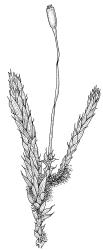Plants forming cushions usually on bark or rock. Stems creeping and much branched, forming a densely intertwined mat and giving rise to numerous erect branches. Microphyllous secondary branches frequently present. Leaves lanceolate, oblong-lanceolate, or broadly oblong, often plicate, unbordered, serrulate above, not decurrent, usually abruptly tapered to a fine acumen or pilifer which is uniseriate apically; mid laminal cells vermicular, smooth, firm-walled, variably porose; cells at insertion shorter and wider; alar cells not or poorly differentiated. Costa single, often branched, weak and usually less than ½ the leaf length. Axillary hairs reportedly present.
Dioicous, sometimes with dwarfed ♂ plants. Capsules erect, symmetric, smooth and weakly constricted below the mouth when dry; exothecial cells irregular in outline, l:w mostly less than 2:1, firm-walled; stomata restricted to capsule base; annulus persistent, composed of a single row of cells. Peristome single or double; exostome teeth absent or rudimentary; endostome hyaline, with a low basal membrane and narrowly perforate segments, linear or irregular in outline, lacking nodules and appendiculae; cilia usually absent but rarely rudimentary. Operculum obliquely rostrate from a high conic base. Calyptra cucullate, smooth. Spores spherical, smooth or nearly so.
The Lepyrodontaceae are considered here to be monotypic, with the sole genus, Lepyrodon, distributed in Australasia and tropical and temperate South America north to Mexico.
The family was treated as monotypic and placed in the order Isobryales in the general relationship of the Ptychomniaceae and the pantropical Prionodontaceae by Brotherus (1925). Goffinet et al. (2009) also considered the family to include a single genus; they placed it in the order Hypnales in the general relationship of Orthorrhynchiaceae and Neckeraceae.
A proposal to shift Dichelodontium into the Lepyrodontaceae by Allen (1999), based partly on peristome studies by Magill (1987), is not accepted here. Molecular studies by Bell et al. (2007) show Dichelodontium to be strongly nested within a clade with other members of the Ptychomniaceae, and therefore Dichelodontium is placed in that family here.
The family was treated for Australia by Klazenga (2012).
The generic description given below applies to the family.
| Category | Number |
|---|---|
| Indigenous (Non-endemic) | 2 |
| Total | 2 |




